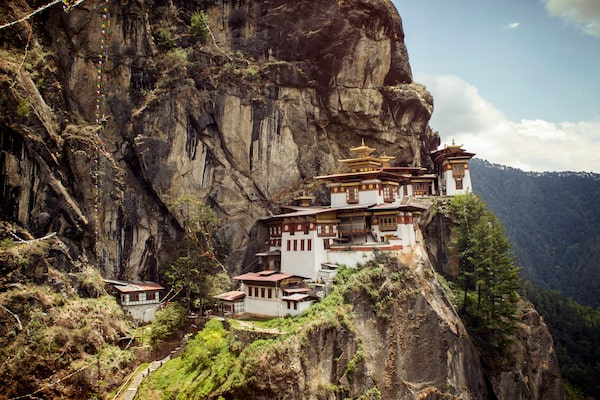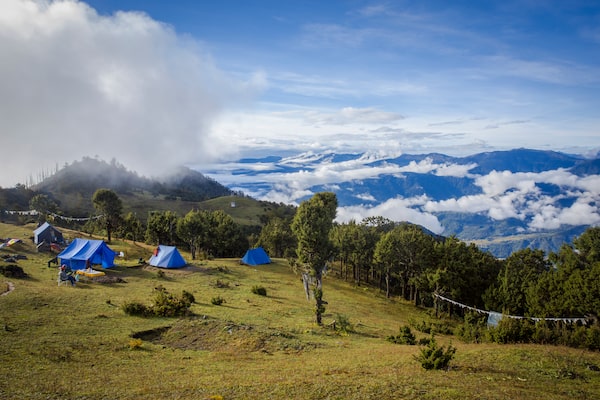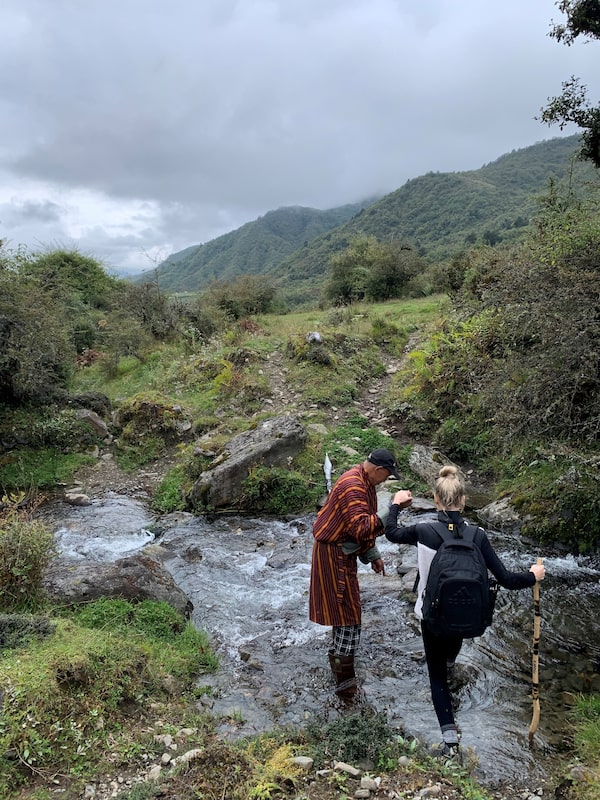
Taktsang Monastery hangs precipitously off a mountain cliff over Paro, Bhutan.G Adventures/The Globe and Mail
In the swirling mist atop a lonely mountain pass in Bhutan, Dawa Tshering, 73, stood twirling an umbrella. A gentle rain spit down at Pele-la Pass and a chilly breeze tugged at Dawa’s gho – a dark red and yellow striped, knee-length garment, tied at the waist. For warmth, he’d tucked plaid flannel pants into a worn pair of rubber boots.
His gap-toothed grin was kind while he waited for a group of foreign hikers to get their packs secured, water bottles filled, gaiters fastened, GoreTex coats zipped, rehydrating sachets at the ready and so on. The only piece of gear he’d brought was that umbrella, which would double as a hiking pole later.
Why is Bhutan’s visitor fee US$200 per day?
Dawa Tshering, 73, leads hikers on the Trans Bhutan Trail that runs through his valley.Florian Sanktjohanser
Dawa had spent his youth on this scenic section of the Trans Bhutan Trail, plus much more of the 403 kilometre cross-country route, when it was the only way to reach villages in neighbouring valleys. He’d carry out sacks of chilis and bring home bags of rice.
Now, he leads hikers into the alpine valley – it’s practically his backyard – through meadows with rhododendrons and wild orchids and trees full of grey-bearded monkeys, along grassy fields dotted with rough wooden huts that yak herders live in when the beasts come down from the mountains, past grazing cattle and cow patties, and over rushing rivers – bridges optional.

Catered camping along the Trans Bhutan Trail is a popular way for many hikers to spend the night.G Adventures/The Globe and Mail
Eight kilometres away Dawa’s family was preparing a traditional meal for the foreign visitors in the village of Rukubji but that was some hours away yet. He must have wondered if we’d ever get moving.
Bhutan is in the Eastern Himalayas, a kingdom wedged under China and the Tibetan plateau, with India to the south. It’s a country of mountains and valleys and it’s carbon neutral – 72 per cent of Bhutan is forested, and 60 per cent of it will remain so by law, it also exports hydro-electric power. Bhutan is only 300 km long and 150 km wide but rich with biodiversity: home to 5,400 plant species and more than 770 birds and 200 mammals, including the snow leopard, Bengal tiger and black necked crane. Only two airlines – Drukair and Bhutan Airlines – fly here and only local pilots are trained to make the tricky landing in Paro, where a short, high-altitude runway hemmed in by the Inner Himalayan range gives visitors their first thrill.
Remote geographically, Bhutan once kept the world at bay culturally. Television and internet didn’t arrive until 1999. Visitors have been few but when they do arrive, they discover a Buddhist culture that’s strong and uniquely Bhutanese. Traditional dress – the gho and ankle-length kira for women – is commonly worn. Gurus and saints have their own local flair – a popular one used sex appeal to spread Buddha’s teachings, and so, yes, that is an enormous penis painted on many homes’ exterior walls, or a tiny one engraved on that school bell – the phallus holds a sacred place. And Bhutan’s famed Gross Domestic Happiness program, launched in 2008, still means sustainable socio-economic development, cultural preservation and environmental conservation is more important than financial gain.
Once our group finally set off, I patted the white painted trail marker happily for luck. It was erected during the Trans Bhutan Trail restoration, a massive pandemic project for the Bhutanese funded by a $1-million gift from Toronto travel entrepreneur-turned-philanthropist Sam Blyth. He’s been drawn to the country since 1988. An avid hiker, he calls the TBT one of the greatest long-distance trails in the world: “The sheer beauty, in terms of the cultural aspect, the pristine nature of the environment … the warm welcome. It’s right up at the top.”
But he, like everyone in Bhutan, was quick to defer to the King, who is revered here, as the man with the “vision” of the trail – as a way to bring Bhutanese back to their history and away from outside influences that are changing the culture, such as consumerism, fast foods, fewer people in traditional dress and, like everywhere else in the world, younger people spending more time online than outdoors.
Far from the city streets of Thimphu, Bhutan’s capital, where these changes were soon spotted, our group picked its way downhill through ankle deep heather and muddy bogs. Dawa’s big rubber boots made a lot more sense, now. I stopped short when I reached a stream that was too wide to jump. But Dawa bent over, dug out a few stepping-stones, then held out his hand to me and grinned.

Local elder and guide Dawa Tshering, 73, leads hikers across the stream safely.Catherine Dawson March/The Globe and Mail
Safely across, I walked on, taking my time through the grasslands to admire the mountains, which rose sharply on either side. One is thickly treed with Himalayan pine and wreathed in mist, but thinning clouds on my left revealed terraced fields with crops of bright yellow mustard seed, which stood out amidst the emerald green. Occasionally, a truck wound its way up the country’s one highway of hairpin turns but it wasn’t audible – in the valley silence is broken only by cattle and cameras.
At mid-morning, Dorji, our local G Adventures fixer, pulled out a Bhutanese energy treat: Chugo, or yak cheese, white, powdery, one-inch cubes threaded onto a red string, which she purchased from a roadside stall. It reminded me of those candy necklaces from childhood – but a chunk of chugo is rock hard, and stayed that way in my mouth for a long, dry 15 minutes. Only when it started to crumble did I note a mild milky flavour. Chugo is one local treat I’ll leave behind.
After a few hours, Dawa and Dorji began talking urgently. A couple of Bengal tigers had been spotted on the after-lunch portion of the trail. Rangers were hastily arranged, though they’d be armed with tranquillizer darts, not guns. The Bhutanese do not kill. Not even the leech that, fully engorged, wiggled out of my sock during lunch later that day.

Monks are a common sight in Bhutan, outside a monastary and in the streets.Catherine Dawson March/The Globe and Mail
As honoured guests, we’d been served our meal in the shrine room of Dawa’s home. We sat on floor mats before an altar that gleamed with deities, holy books and many bowls of offerings. Horrified to be bleeding in this sacred space, I pulled off my bloody sock and hustled it to an outer room. Dorji scooped the parasite off the floor and followed to clean my ankle.
In the end, the tigers and bad timing meant that day’s hike was over. Our group would trek other stunning sections of the trail – through rainforests and rocky scrambles with grand views – but this day would be my favourite. Mostly because Dorji had set my leech free outside with a prayer. This thrilled me. Now I had a blood tie to the country.
Before this trip, Bhutan was not on my radar. But I soon realized that – once you start hiking into its aching natural beauty, once you start learning about its religion, once you get to know its laid-back people who love to laugh – this Himalayan country is about as close to the mythical kingdom of Shangri-la as you’re ever going to get.
If you go
In September, Bhutan began charging visitors US$200 a day to reinvest in the country. “I want every visitor to think that even though it was a little bit more expensive, that it was worth it,” Prime Minister Lotay Tshering said.
A great primer to the beauty of Bhutan is the 2019 Oscar-nominated film Lunana: A Yak in the Classroom (currently on Netflix).
G Adventures offers eight tours in Bhutan. Many include non-technical trekking on the Trans Bhutan Trail and all include time with locals, plus the hike to Taktsang (Tiger’s Nest) Monastery, which hangs off a mountain outside Paro. Exploring the shrines of Taktsang is one of the most memorable things you can do in Bhutan. Tours start from $3,699, and do not include airfare. gadventures.com
If you are flying this far, make the most of it with a layover in one of your transfer countries. An extra night in Bangkok meant a grand day of tuk-tuk and longtail boat rides to explore the city. My G Adventures guide bypassed the usual tourist spots to show me to his favourite neighbourhoods and cafes, and whet my appetite for a longer visit next time.
The writer was a guest of G Adventures. It did not review or approve the story before publication.
Keep up to date with the weekly Sightseer newsletter. Sign up today.
 Catherine Dawson March
Catherine Dawson March